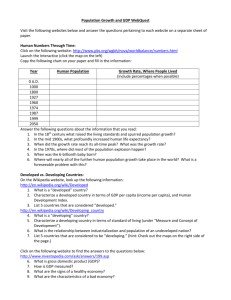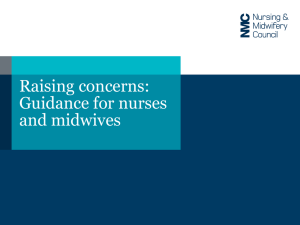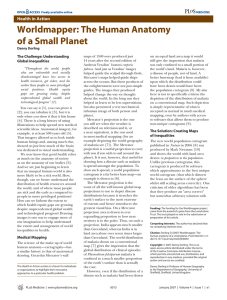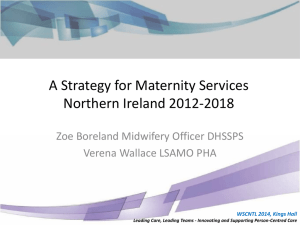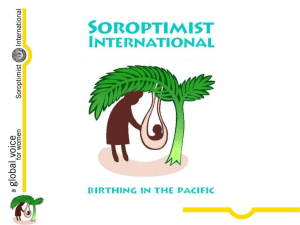The CSIH`s powerpoint presentation “improving
advertisement
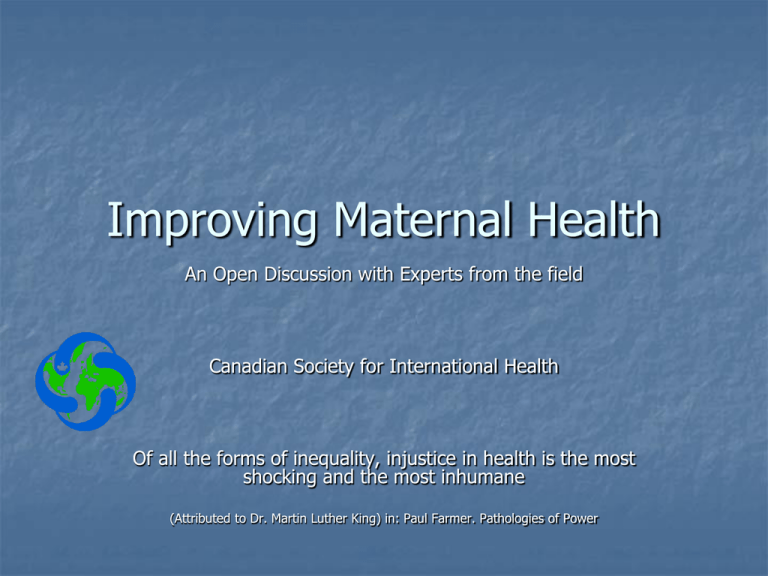
Improving Maternal Health An Open Discussion with Experts from the field Canadian Society for International Health Of all the forms of inequality, injustice in health is the most shocking and the most inhumane (Attributed to Dr. Martin Luther King) in: Paul Farmer. Pathologies of Power An Issue of Inequity Setting the Context Distribution of the World’s Wealth Russian Federation UK Germany China USA Switzerland France Spain Italy Bangladesh India Philippines Fr Guyana Indonesia Australia www.worldmapper.org www.worldmapper.org Distribution of Poverty in the World Russian Federation Canada USA China Bangladesh India Ethiopia Thailand Philippines Kenya Indonesia South Africa Australia www.worldmapper.org Girls not at Secondary School "... my father thinks it’s a waste letting me go to school. It’s better for my family to let me work than go to school. My father also says it’s easier for men to tell girls what to do if they Worldmapper.org World Health Expenditure Data (% of GDP) SOURCE: WHO (2002) Patterns of Global Health Expenditures: Results for 191 Countries EIP/HFS/FAR Discussion Paper No. 51 Nurses Working "[they] are also being poached by industrialised countries. There are more nurses from Malawi in Manchester than in Malawi …" Glenys Kinnock, 2005 Worldmapper.org A Global Response which is supported by Canada: Global Health Workforce Alliance A new global partnership that will strive to address the worldwide shortage of nurses, doctors, midwives and other health workers was launched today. The Global Health Workforce Alliance will draw together and mobilize key stakeholders engaged in global health to help countries improve the way they plan for, educate and employ health workers. Its secretariat will be hosted by the World Health Organization (WHO). Responding to the call by African Heads of State, the G-8 and the World Health Assembly for urgent solutions to the health workforce crisis, the Alliance will seek practical approaches to urgent problems such as improving working conditions for health professionals and reaching more effective agreements to manage their migration. It will also serve as an international information hub and monitoring body. (WHO) Five Strategies: To address the Health and Human resource Deficit which will have and impact on maternal health Mobilizing direct financial support for health training institutions, through a model similar to that of the Education for All Fast Track Initiative - a global partnership between donor and developing countries to ensure accelerated progress towards the Millennium Development Goal of universal primary education; Training partnerships between schools in industrialized and developing countries involving exchanges of faculty and students, with the aim of improving the education of doctors, nurses, midwives and paraprofessional health workers, and training more of them now; Nurturing a new generation of academic leaders in developing countries with the support of experts in the clinical, public health and managerial sciences from around the world; Developing innovative approaches to teaching in developing countries with state-of-the art teaching materials and continuing education through information and communications technology; Assistance with the creation of planning teams in each country facing health worker shortages, drawing on the top leadership of the major schools, whose task will be to develop a comprehensive national health workforce strategy. (Source WHO)h Where the greatest inequities exist: Sub-Saharan Africa faces the greatest challenges. While it has 11 percent of the world's population and 24 percent of the global burden of disease, it has only 3 percent of the world's health workers. A 7000 times greater risk of dying in SSA than in Canada in childbirth (WHO) IMPACT There is a direct relationship between the ratio of health workers to population and survival of women during childbirth and children in early infancy. As the number of health workers declines, survival declines proportionately. (WHO) Midwives Working "The lives and health of many millions more would be saved with greater investments in midwives." Thoraya Ahmed Obaid, 2006 Worldmapper.org Illiterate Young Women "My dream now is to become a teacher and work here at the Kuchinerla School and help people in our villages understand the dangers of working in the cotton fields and the importance of girls’ education." Vijaya Lakshmi, 2006 Worldmapper.org Maternal Mortality Worldmapper.org New frameworks for sustainable health and human development within a context of human rights are required which consider the contribution of health and social programmes to economic development and promotes complimentary actions in all development efforts (Kreisel, 1997) New and emerging challenges to health and development include: globalization, human rights violations, environmental degradation, population transitions/growth and migration and health system reform which requires a new type of health system decentralization of the social sector to the local level means that local action is becoming more important As these health systems reform and reshape it will require interconnecting webs constituting new relationships and partners resulting in strengthened or new institutional and community interaction: ngo’s are key to this interaction Specifically with the health care sector there must be a balancing of the goals of providing fair access to health care (equity), efficiently allocating resources and services, and responding to the needs of the population and health care providers Improvements to the health care system cannot be achieved just by allocating more resources to this sector; resources be shifted to respond to community needs and to address the need for sustainable and integrated approaches to health promotion Ensuring public participation in decisions about health planning and the allocation of resources is particularly key. It encourages action by communities to demand health as their right Non-government organizations often support or provide the mechanisms by which such public participation is ensured and institutionalized in planning and decision making processes What is needed? A Health Systems Response A Health Systems Response Vision: Equity and Accountability “ Stewardship and Leadership Social Determines of Health Framework Health Human Resources Health Financing and Resource Allocation Research for Development (Evidence-Based planning and policy-making) Health in all policies ” Health Information Systems Data for Decision-making Evidence-Based Decision-Making (Clinical and Community-based) Service delivery treatments and programs Community interventions and health promotion Strong and vibrant Civil Society Transparent and Accountable Public/Private Sector Copyright CSIH 2005 If health is a human right, it has to be distributed in a fairer or more equitable manner utilizing processes of reform and capacity building within the health system We therefore need to get better at transferring and adapting models that will promote a fair distribution of access and availability of services for health care and strengthen the systems infrastructure to improve accountability (eg., health information systems) We need to promote coverage for basic services which are universally accessible and available (Next year’s WHO Report: Universal Health Coverage) Finally we have to promoting the understanding that the determinants of health and the inequitable “loading” of those determinants: poverty, education, environmental risks, gender, employment, peace…have a greater impact than health care in the improvement of health status INTERSECTORAL COLLABORATION FOR MATERNAL HEALTH EQUITY IS Need for KEY coherence Development Security Trade Health Maternal Health Policy Labour Environment Human Rights Foreign Affairs Interact with related policy domains Source IOM 2007 Strengthening Health Systems with Human Resources Reflective Questions Strengthening Health Systems for Human Resources How does our work strengthen the human resources responsible for delivering preventive health services and treatment in targeted communities? What is being done to strengthen the human resources in the environment in which we work? How do we ensure that the human resources for health are stronger as a result of our work?
